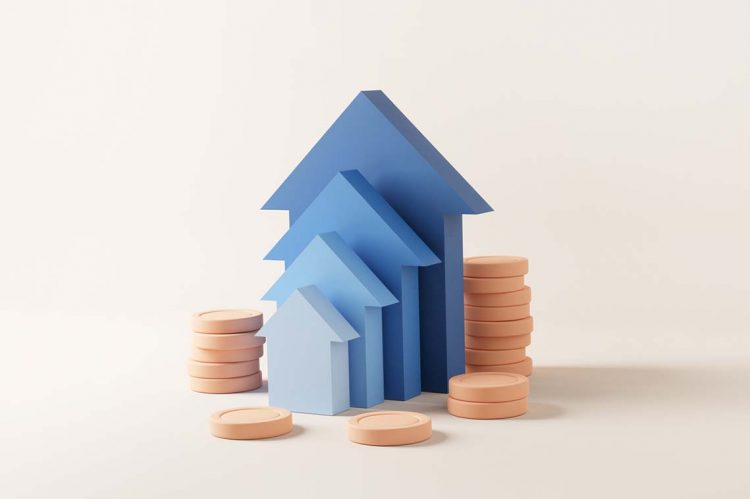After months of tapping the brakes on home value appreciation, the start of spring saw some modest acceleration in prices of single-family homes, according to the most recent S&P CoreLogic/Case-Shiller Indices.
The index showed that home prices appreciated 20.6% in March, up from 20% in February. All 20 cities saw annual price growth as the 10- and 20-City Composites rose 19.5% and 21.2%.
While markets in the Sun Belt maintained the most significant annual price growth in March, Tampa seized the top spot with a YoY increase of 34.8% in prices, unseating Phoenix, which has led the pack for the past three years. Phoenix saw a 32.4% increase in home prices while Miami tallied a 32% increase.
March’s results broke from the decelerating price growth trend that has taken hold since the start of the year. Experts maintained that a slowdown in price appreciation is still the likely outcome in the market amid elevated mortgage rates and ongoing efforts by the Federal Reserve to reel in inflation.
The complete data for the 20 markets measured by S&P:
Atlanta, Ga.
March/February: 3.1%
Year-Over-Year: 25.7%
Boston, Mass.
March/February: 2.6%
Year-Over-Year: 14.5%
Charlotte, N.C.
March/February: 2.9%
Year-Over-Year: 26.0%
Chicago, Ill.
March/February: 1.5%
Year-Over-Year: 13.0%
Cleveland, Ohio
March/February: 2.3%
Year-Over-Year: 14.7%
Dallas, Texas
March/February: 4.3%
Year-Over-Year: 30.7%
Denver, Colo.
March/February: 4.5%
Year-Over-Year: 23.7%
Detroit, Mich.
March/February: 2.6%
Year-Over-Year: 15.4%
Las Vegas, Nev.
March/February: 3.1%
Year-Over-Year: 28.5%
Los Angeles, Calif.
March/February: 3.3%
Year-Over-Year: 23.2%
Miami, Fla.
March/February: 3.6%
Year-Over-Year: 32.0%
Minneapolis, Minn.
March/February: 2.1%
Year-Over-Year: 12.4%
New York, N.Y.
March/February: 1.6%
Year-Over-Year: 13.7%
Phoenix, Ariz.
March/February: 3.0%
Year-Over-Year: 32.4%
Portland, Ore.
March/February: 2.9%
Year-Over-Year: 19.3%
San Diego, Calif.
March/February: 3.7%
Year-Over-Year: 29.6%
San Francisco, Calif.
March/February: 4.3%
Year-Over-Year: 24.1%
Seattle, Wash.
March/February: 5.6%
Year-Over-Year: 27.7%
Tampa, Fla.
March/February: 3.7%
Year-Over-Year: 34.8%
Washington, D.C.
March/February: 2.9%
Year-Over-Year: 12.9%
The takeaway:
“Those of us who have been anticipating a deceleration in the growth rate of U.S. home prices will have to wait at least a month longer,” says Craig J. Lazzara, managing director at S&P DJI. “The strength of the Composite indices suggests very broad strength in the housing market, which we continue to observe. All 20 cities saw double-digit price increases for the 12 months ended in March, and price growth in 17 cities accelerated relative to February’s report. March’s price increase ranked in the top quintile of historical experience for every city, and in the top decile for 19 of them.
“Mortgages are becoming more expensive as the Federal Reserve has begun to ratchet up interest rates, suggesting that the macroeconomic environment may not support extraordinary home price growth for much longer. Although one can safely predict that price gains will begin to decelerate, the timing of the deceleration is a more difficult call.”
“Today’s S&P Case Shiller Index shows another steep rise in prices, with all three indices showing an acceleration of home prices in March, a reflection of an early spring housing market in which buyers felt immense pressure to bid competitively on the few homes available for sale,” said Danielle Hale, chief economist for realtor.com®.
“Mortgage rates surged 91 basis points or nearly a whole percentage point throughout the month of March, as the Fed lifted short-term rates for the first time in 2 years while the economy adjusted to lingering inflation and the then-new conflict in Ukraine.
“Regionally, we continue to see the biggest price gains in relatively affordable Sunbelt markets. However, with lower housing costs drawing people from elsewhere and existing residents choosing to stay in these areas, builders have not yet been able to keep up with demand, causing both home prices and rents to surge.
“Fast-forward to the most recent data from last week, and the housing market has shifted. We’ve observed a real estate refresh that has more sellers listing homes leading to greater availability of homes for sale compared to this time last year. Meanwhile, mortgage rates have steadied but remain near the highest levels in 13-years. But importantly, sales data for both new homes and existing homes signal that buyers are increasingly unable or unwilling to make a home purchase under these conditions. As buyer confidence sags and weighs down demand, real estate markets will re-balance, eventually tilting away from the heavy advantage that recent home sellers have enjoyed. This will initially mean fewer home sales, which should diminish the bidding wars and concessions that buyers make to sweeten offers.
“Eventually, we expect a more moderate pace of listing price growth, with for-sale homes that sit for longer than the record pace we’ve seen in recent months. Somewhat counterintuitively, conditions shifting back in buyers’ favor will likely benefit many of today’s sellers, nearly three-quarters of whom also plan to buy a home this year. While fundamental homebuying demand is expected to remain high thanks to large numbers of young households, mortgage payments still have to be manageable. Mortgage costs are nearly 50% higher today than they were at this time last year. Unless incomes grow by double-digits or mortgage rates dip, neither of which seems especially likely, households will have to look for other options,” Hale concluded.












